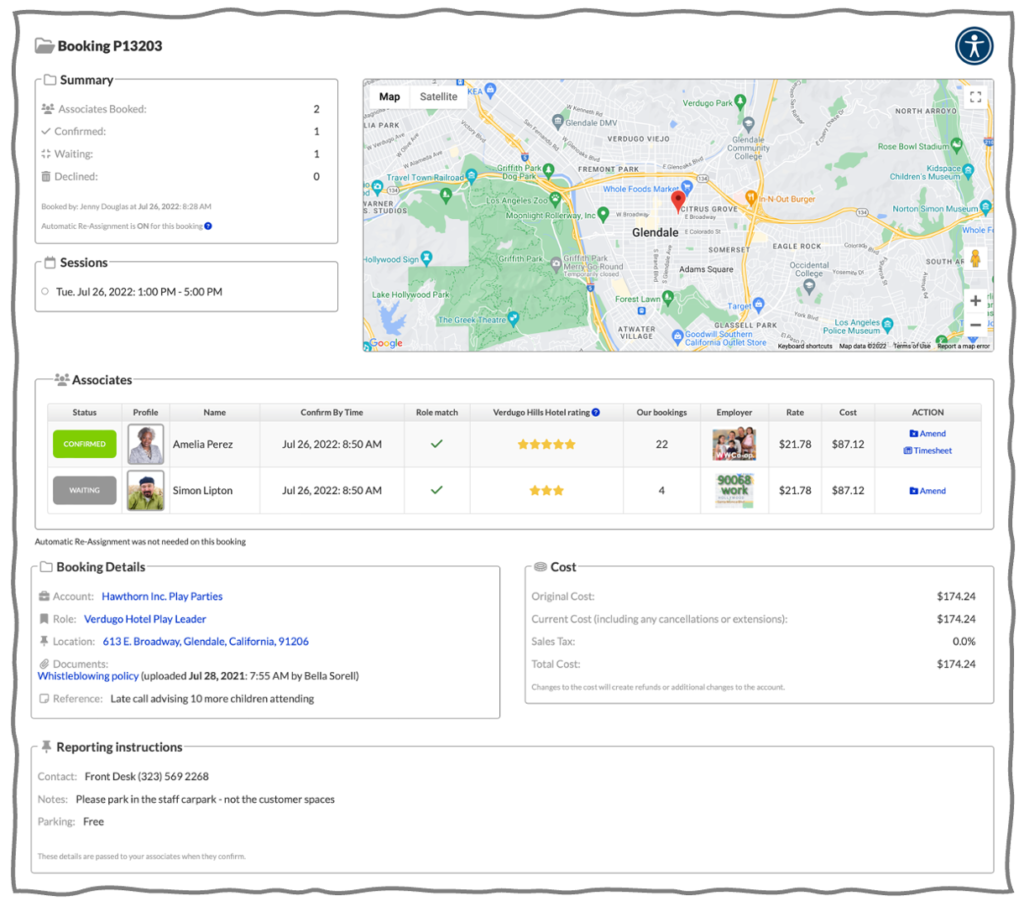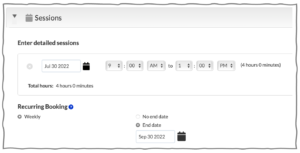 A hotel starts a side business offering children’s parties. They need extra workers for each event.
A hotel starts a side business offering children’s parties. They need extra workers for each event.
Specifying the work
 Hotel managers don’t want to rely on high-overhead, churning, temp agencies. Through their Chamber of Commerce, they heard about local launch of a version of GoodFlexi and signed up through one of the intermediaries involved.
Hotel managers don’t want to rely on high-overhead, churning, temp agencies. Through their Chamber of Commerce, they heard about local launch of a version of GoodFlexi and signed up through one of the intermediaries involved.
A generic role (work type) isn’t good enough. So, the intermediary created a role specifically for the hotel with stipulated badges each worker must have up to date and a fixed hourly payrate of $16.28.
Workers living within 5 miles of the hotel with the required badges were offered the role, and the payrate. With 25 offers, 17 of the qualifying workers currently have the role set at accepted. If that figure starts to drop it gives the hotel early warning their payrate is no longer competitive, or workers aren’t enjoying their bookings.
Party up
It’s a Tuesday morning. Reception have just learned a birthday event scheduled for this afternoon is going to involve 10 more kids than planned. They need two extra workers. An authorized manager logs on through the intermediary’s website. She enters the role and location. Immediately she can see how many of the hotel’s approved top-up workers are available each hour for the next ten weeks:

The hotel also uses GoodFlexi’s “Accounts” functionality. A local biotech company has a monthly budget for play parties for employees’ children. That will be billed for today’s gathering. The system tops up, deducts, refunds, and ensures no overspending as bookings are made then changed.
Selecting the workers
Once the manager has selected her hours, she sees all the workers who (a) have been offered then accepted the role (b) are available at the times required (c) have rules on period of notice, minimum shift lengths, travel distance, etc. that permit this booking.
Workers come from the hotel’s intermediary and their partner intermediaries. To keep themselves exposed to new talent, the hotel has chosen a “Top-up role”. So, GoodFlexi is also finding available, willing, workers who have all the badging to comply with a generic “Physical Activities with Children” role. These people have no relationship with the hotel. But they could safely be used to supplement numbers at any time.

A photo of each worker will expand into a profile of their work record and badging. To simplify selection, the hotel uses GoodFlexi’s ratings function. These ratings are not published anywhere, they are a record of each worker’s training by hotel staff. Top of the list is Amelia who has been marked for “Automatic Job Interview”. She has done good work during on-demand assignments; the hotel will try to tempt her into a job when they have a full-time vacancy.
The manager clicks for two of the hotel’s pool of approved flexible workers. After confirming some reporting instructions, she lands on a screen that tracks her booking. Amelia has been texted and confirms immediately. The other worker has 22 minutes to do so. If he doesn’t, the system can be set to automatically offer it to the next best person on the hotel’s list.

Timesheets
A printable electronic timesheet is automatically created for each worker for the booking. Exact times of work can be populated from the worker’s phone using a check-in/check-out tool that also captures their location, creating a legal record of the work to avoid disputes.

Each timesheet moves through a series of statuses until it is processed; sent for payrolling and invoicing with all parties having confirmed the record of work performed.
Advanced functions for clients and intermediaries
- Partnering: Each intermediary can choose to allow their workers to be booked by clients of selected other intermediaries. It’s a way of growing everyone’s opportunities. The platform will administer whatever rules on margin-splitting the two parties agree on.

- Working Time Controls: Templates of controls on maximum hours, minimum breaks and banned times of work can be set up. Any template can then be applied to any worker. It’s useful, for example, if young workers are allowed in or if a college principal will only allow students to work if their studies are prioritized.
 Recurring bookings: Need for top-up workers for a few hours a week can be predictable. GoodFlexican easily create on-going arrangements with a worker that last for weeks, or are open-ended. It’s a step towards job creation.
Recurring bookings: Need for top-up workers for a few hours a week can be predictable. GoodFlexican easily create on-going arrangements with a worker that last for weeks, or are open-ended. It’s a step towards job creation.- Job pathways: Within controls, anyone with a job to fill can search for irregular workers with the right experience, living in the right area, who want to move to full-time.
- Reporting/analytics: The platform produces very granular data on demand, supply, earnings, and patterns of activity for any type of work, sub-geography, or worker attribute. This identifies skills shortages in advance; a lack of careworker availability next Easter for instance.

